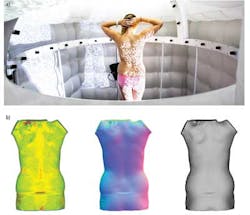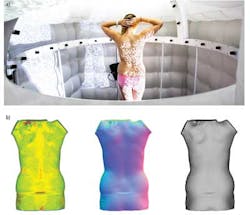3-D IMAGING: 3-D modeling improves spinal casting process
Scoliosis, a sideways curvature of the spine, can occur for a number of reasons, including injury and birth or neuromuscular defects. X-rays are used to assess the condition of a patient with scoliosis, and several methods exist to correct it.
Surgery may be required to correct the most extreme forms of scoliosis, but other treatments such a corset may also be used. Because each patient will exhibit different types of spinal curvature, these corsets must be customized for the individual.
In the past, production involved making a plaster cast of the patient's spine from which a mold of the corset could be fabricated. This required the patient to remain stationary while the cast formed. After the plaster cast is fabricated, the physician can use the formed cast as the basis to develop a corrective corset for the patient.
For children affected with this disorder, this time-consuming process requires a customized casting table and sometimes anesthesia, thus causing the patient inconvenience and discomfort; drying of the plaster can actually be a painful procedure. After monitoring the patient's progress, further casts are often needed, requiring the procedure to be repeated multiple times.
b) After generating a 3-D CAD model of the spine, a CNC machine can be used to generate the corset.
To overcome the limitations of the corset development approach, engineers at 4DDynamics have developed a 3-D system that can be used to develop prosthetic corsets in less than half a day (see figure). To image the spine of a patient, 24 XCDSX90 1.3-Mpixel FireWire cameras from Sony are arranged in a circular fashion such that the spine can be imaged from 24 separate angles, capturing the full back and belly area within 1/30 of a second. The 3-D data are available to the physician within minutes.
"Because the patient's spine may not have discernible features, a digital light projector [DLP] from Optoma [www.optoma.com] is used to project random patterns onto the torso, providing the opportunity to work with standard settings without user input," says Denise Grauzinis, president and chief executive officer of 4DDynamics. "In this way, the surface of the spine will exhibit known patterns that can be used to match known features on the surface of the spine using a multiview stereo approach."
After images are transferred over FireWire to a host PC, a multiview stereo reconstruction algorithm is used to recreate a 3-D model of the spine from the known camera viewpoints. The data are merged and reconstructed automatically without any user input; a patient file also is being created and a QR code referring to this patient file is being printed automatically. Thus, rather than create a plaster-cast model of the spine, the system can generate a digital equivalent model in less than 1 sec.
This 3-D model can be analyzed by a physician, modified as required, and used as input to a computer numerical control (CNC) machine to fabricate the custom prosthetic corset, a process that takes less than one day.
"Using 3-D scanning technology in this manner," says Grauzinis, "eliminates the need for customized casting tables, dramatically reducing the time required to both create a 3-D representation of the spine and generate a prosthetic corset. And it can be done by any nontechnical personnel without any computer knowledge."
At an entrée license cost of around €35,000, the system is developed based on input data and on request of a medical facility in Hungary, currently producing several corsets on a daily basis. To gain wider acceptance, Grauzinis is looking to license the system to selected medical facilities in Europe.

